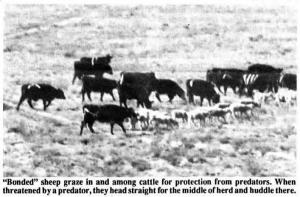1990 - Volume #14, Issue #2, Page #33
[ Sample Stories From This Issue | List of All Stories In This Issue | Print this story
| Read this issue]
Cattle Protect Sheep
 |
It works like this: By nature cattle will fight off coyotes, so researchers have trained sheep to graze in and among cattle. The cattle may not care about the sheep, but they'll tolerate them and ward off any coyotes who come too near. The idea of bonding sheep to cattle is based on some tried and true ideas. It's been known for a long time that sheep can become attached to other animals, such as goats or donkeys, and then follow them around. Moreover, raising sheep and cattle on the same land is not new and is, in fact, common in the South-west, especially Texas.
But the idea of bonding sheep to cattle for coyote protection is new. It came out of work at a USDA experiment station in Las Cruces, New Mexico.
Two Jornada scientists, Dr. Dean M. Anderson and Dr. Clarence V. Hulet, were looking for ways to combine sheep and cattle on the same range, figuring this would create more productive use of land than with either sheep or cattle alone. They found the cattle did well, but the sheep fell easy prey to coyotes.
The scientists say that when they first started running sheep at the station they lost half the flock to coyotes. They tried electric fences but they couldn't always maintain them to keep the coyotes out. They also tried guard dogs, which are effective, but they're costly and couldn't protect all the sheep at once. That's when they got the idea of bonding the sheep to a larger animal. They knew that a nursing calf beside its mother is almost never killed by predators. A cow can and will chase off a coyote or whatever else threatens her young. Even when there are no calves to protect, cattle have a natural hostility toward coyotes.
Normally when sheep and cattle graze together, they go off to opposite ends of a pasture. To create mixed herds, newly weaned lambs, about 45 days old, are put in a small feedlot pen with young cattle for 60 days. A mix of two lambs per heifer works well, with a maximum of 7 lambs and 3 heifers in any one pen. When the 60 day period is over, the animals are turned loose on the range, where the now bonded sheep continue to flock with their larger friends, the cattle.
Bonded sheep, when threatened with a predator, will head straight for the middle of the herd and huddle there. If the herd moves, they move. Because the cattle face to the outside and toward the approaching coyotes, the sheep behind them are naturally protected.
"It's dramatic," says Hulet. "We tried an experiment where we put bonded and unbonded sheep in adjoining pastures and we switched sides after every kill, so we'd know that the predators weren't choosing one pasture over another. We stopped after we had lost 50% of the unbonded sheep, but none of the bonded sheep had been killed."
One problem is that bonded sheep stick so close to the cattle that it can become difficult to separate them from the herd when necessary. Another problem is that some cattle just don't like sheep and will butt them, kick them and chase them off. Out of the 80 cattle tested, the scientists found two like this.
Anderson points out that sheep don't bond with individual cattle. They just be-come attracted to cattle in general. This has some potential to cause problems. "If sheep see other cattle in a neighboring field, they may wander over to them., One cow is as good as another to a sheep. This is where good fencing and management are essential."
Mixed cattle and sheep makes at least one job easier. "Unbonded sheep wander off and can be hard to find among the tall brush," Hulet explains. "But it's easy to find cattle, and now the sheep stay with the cattle."
Cattle ranchers also benefit from mixed herds. Because cattle eat grasses while sheep prefer broad-leaved weeds, a mixed herd increases the total livestock the land will support.
Contact: FARM SHOW Followup, Dr. Clarence Hulet, Jomada Experimental Range, Box 30003, Las Cruces, N.M. 88003 - 0003.

Click here to download page story appeared in.

Click here to read entire issue
To read the rest of this story, download this issue below or click here to register with your account number.




